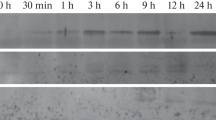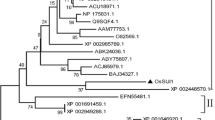Abstract
A flower-predominant cDNA for a gene, termed OsChia1;175, was isolated from a cDNA library of rice pistils. Northern blot and RT-PCR analyses revealed that the OsChia1;175 gene is highly expressed in floral organs (pistils, stamens and lodicules at the heading stage) but not or at an extremely low level in vegetative organs. OsChia1;175 encodes a protein that consists of 340 amino acid residues, and the putative mature protein shows 52% to 63% amino acid identity to class I chitinases of rice or other plants. The phylogenetic tree shows that the OsChia1;175 protein is a new type of plant class I chitinase in rice. The expression of OsChia1;175 in vegetative organs is not induced by several chemicals, UV, and wounding. The soluble putative mature OsChia1;175 protein expressed in Escherichia coli exhibited chitinase activity in the assay with colloidal chitin as a substrate. Genomic Southern analysis revealed that the OsChia1;175 gene was organized as a low-copy gene family. The rice genomic library was screened and a genome clone corresponding to OsChia1;175 was isolated. The transcription start sites of the OsChia1;175 gene were mapped by primer extension analysis. The 1.2 kb putative promoter region of the OsChia1;175 gene was fused to the GUS (β-glucuronidase) gene, and this chimeric gene was introduced to rice by Agrobacterium-mediated transformation. The flower-predominant gene expression was identified also in the transgenic rice plants. The high promoter activity was detected in the stigmas, styles, stamens and lodicules in transgenic plants. The possible functions of OsChia1;175 are discussed.
Similar content being viewed by others
References
Atkinson, A.H., Heath, R.L., Simpson, R.J., Clarke, A.E. and Anderson, M.A. 1993. Proteinase inhibitors in Nicotiana alata stigmas are derived from a precursor protein which is processed into five homologous inhibitors. Plant Cell 5: 203–213.
Bause, E. 1983. Structural requirements of N-glycosylation of proteins. Studies with proline peptides as conformational probes. Biochem. J. 209: 331–336.
Bradford, M.M. 1976. A rapid and sensitive method for the quantitation of microgram quantities of protein utilizing the principle of protein-dye binding. Anal. Biochem. 72: 248–254.
Broglie, K., Chet, I., Holliday, M., Cressman, R., Biddle, P., Knowlton, S., Mauvais, C.J. and Broglie, R. 1991. Transgenic plants with enhanced resistance to the fungal pathogen Rhizoctonia solani. Science 254: 1194–1197.
Chen, C.G., Cornish, E.C. and Clarke, A.E. 1992. Specific expression of an extensin-like gene in the style of Nicotiana alata. Plant Cell 4: 1053–1062.
Collinge, D.B., Kragh, K.M., Mikkelsen, J.D., Nielsen, K.K., Rasmussen, U. and Vad, K. 1993. Plant chitinases. Plant J. 3: 31–40.
de Jong, A.J., Cordewener, J., Lo Schiavo, F., Terzi, M., Vandekerckhove, J., van Kammen, A. and de Vries, S.C. 1992. A carrot somatic embryo mutant is rescued by chitinase. Plant Cell 4: 425–433.
de Jong, A.J., Heidstra, R., Spanik, H.P., Hartog, M.V., Meijer, E.A., Hendriks, T., Loschiavo, F., Terzi, M., Bisseling, T., van Kammen, A. and de Vries, S.C. 1993. Rhizobium lipooligosaccharides rescue a carrot somatic embryo mutant. Plant Cell 5: 615–620.
Harikrishna, K., Jampates-Beale, R., Milligan, S.B. and Gasser, C.S. 1996. An endochitinase gene expressed at high levels in the stylar transmitting tissue of tomatoes. Plant Mol. Biol. 30: 899–911.
Heidecker, G. and Messing, J. 1986. Structural analysis of plant genes. Annu. Rev. Plant Physiol. 37: 439–466.
Hiei, Y., Ohta, S., Komari, T. and Kumashiro, T. 1994. Efficient transformation of rice (Oryza sativa L.) mediated by Agrobacterium and sequence analysis of the boundaries of the T-DNA. Plant J. 6: 271–282.
Hoshikawa, K. 1989. The growing rice plant. Nosan Gyoson Bunka Kyokai (Nobunkyo), Tokyo.
Iseli, B., Boller, T. and Neuhaus, J.M. 1993. The N-terminal cysteine-rich domain of tobacco class I chitinase is essential for chitin binding but not for catalytic or antifungal activity. Plant Physiol. 103: 221–226.
Jefferson, R.A., Kavanagh, T.A. and Bevan, M.W. 1987. GUS fusions: B-glucuronidase as a sensitive and versatile gene fusion marker in higher plants. EMBO J. 6: 3901–3907.
Joshi, C.P. 1987. An inspection of the domain between putative TATA box and translation start site in 79 plant genes. Nucl. Acids Res. 15: 6643–6653.
Karunanandaa, B., Singh, A. and Kao, T.H. 1994. Characterization of a predominantly pistil-expressed gene encoding a γ-thioninlike protein of Petunia inflata. Plant Mol. Biol. 26: 459–464.
Komari, T., Saito, Y., Nakakido, F. and Kumashiro, T. 1989. Efficient selection of somatic hybrids in Nicotiana tabacum L. using a combination of drug-resistance markers introduced by transformation. Theor. Appl. Genet. 77: 547–552.
Komari, T., Hiei, Y., Saito, Y., Murai, N. and Kumashiro, T. 1996. Vectors carrying two separate T-DNAs for co-transformation of higher plants mediated by Agrobacterium tumefaciens and segregation of transformants free from selection markers. Plant J. 10: 165–174.
Lamb, C.J., Zhu, Q., Yamamoto, R.T., Beeche, A., Nelson, A.J. and Lawton, M.A. 1991. Defense gene regulation. In: Rice Genetics II, International Rice Research Institute, Manila, Philippines, pp. 529–537.
Legrand, M., Kauffmann, S., Geoffroy, P. and Fritig, B. 1987. Biological function of pathogenesis-related proteins: four tobacco pathogenesis-related proteins are chitinases. Proc. Natl. Acad. Sci. USA 84: 6750–6754.
Leung, D.W.M. 1992. Involvement of plant chitinase in sexual reproduction of higher plants. Phytochemistry 31: 1899–1900.
Lin, W., Anuratha, C.S., Datta, K., Potrykus, I., Muthukrishnan, S. and Datta, SK. 1995. Genetic engineering of rice for resistance to sheath blight. Bio/technology 13: 686–691.
Lotan, T., Ori, N. and Fluhr, R. 1989. Pathogenesis-related proteins are developmentally regulated in tobacco flowers. Plant Cell 1: 881–887.
Mariani, C., De Beuckeleer, M., Truettner, J., Leemans, J. and Goldberg, R.B. 1990. Induction of male sterility in plants by a chimaeric ribonuclease gene. Nature 347: 737–741.
Mariani, C., Gossele, V., De Beuckeleer, M., De Block, M., Goldberg, R.B., De Greef, W. and Leemans, J. 1992. A chimaeric ribonuclease-inhibitor gene restores fertility to male sterile plants. Nature 357: 384–387.
McElroy, D., Rothenberg, M., Reece, K.S. and Wu, R. 1990a. Characterization of the rice (Oryza sativa) actin gene family. Plant Mol. Biol. 15: 257–268.
McElroy, D., Rothenberg, M. and Wu, R. 1990b. Structural characterization of a rice actin gene. Plant Mol. Biol. 14: 163–171.
McKnight, S.L. 1982. Functional relationships between transcriptional control signals of the thymidine kinase gene of herpes simplex virus. Cell 31: 355–365.
Memelink, J., Hoge, J.H.C. and Schilperoort, R.A. 1987. Cytokinin stress changes the developmental regulation of several defenserelated genes in tobacco. EMBO J. 6: 3579–3583.
Memelink, J., Linthorst, J.M.H., Schilperoort, R.A. and Hoge, J.H.C. 1990. Tobacco genes encoding acidic and basic isoforms of pathogenesis-related proteins display different expression patterns. Plant Mol. Biol. 14: 119–126.
Neale, A.D., Wahleithner, J.A., Lund, M., Bonnett, H.T., Kelly, A., Meeks-Wagner, D.R., Peacock, W.J. and Dennis, E.S. 1990. Chitinase, β-1,3-glucanase, osmotin, and extensin are expressed in tobacco explants during flower formation. Plant Cell 2: 673–684.
Neuhaus, J.M., Fritig, B., Linthorst, H.J.M., Meins, F. Jr., Mikkelsen, J.D. and Ryals, J. 1996. A revised nomenclature for chitinase genes. Plant Mol. Biol. Rep. 14: 102–104.
Nishizawa, Y. and Hibi, T. 1991. Rice chitinase gene: cDNA cloning and stress-induced expression. Plant Sci. 76: 211–218.
Nishizawa, Y., Kishimoto, N., Saito, A. and Hibi, T. 1993. Sequence variation, differential expression and chromosomal location of rice chitinase genes. Mol. Gen. Genet. 241: 1–10.
Ori, N., Sessa, G., Lotan, T., Himmelhoch, S. and Fluhr, R. 1990. A major stylar matrix polypeptide (sp41) is a member of the pathogenesis-related proteins superclass. EMBO J. 9: 3429–3436.
Raikhel, N.V., Lee, H.I. and Broekaert, W.F. 1993. Structure and function of chitin-binding proteins. Annu. Rev. Plant Physiol. Plant Mol. Biol. 44: 591–615.
Samac, D.A. and Shah, D.M. 1991. Developmental and pathogeninduced activation of the Arabidopsis acidic chitinase promoter. Plant Cell 3: 1063–1072.
Sambrook, J., Fritsch, E.F. and Maniatis, T. 1989. Molecular Cloning: A Laboratory Manual, 2nd ed., Cold Spring Harbor Laboratory Press, Cold Spring Harbor, NY.
Sanger, F., Nicklen, S. and Coulson, A.R. 1977. DNA sequencing with chain-terminating inhibitors. Proc. Natl. Acad. Sci. USA 74: 5463–5467.
Schein, C.H. and Noteborn, M.H.M. 1988. Formation of soluble recombinant proteins in Escherichia coli is favored by lower growth temperature. Bio/technology 6: 291–294.
Schlumbaum, A., Mauch, F., Vögeli, U. and Boller, T. 1986. Plant chitinases are potent inhibitors of fungal growth. Nature 324: 365–367.
Sela-Buurlage, M.B., Ponstein, A.S., Bres-Vloemans, S.A., Melchers, L.S., van den Elzen, P.J.M. and Cornelissen, B.J.C. 1993. Only specific tobacco (Nicotiana tabacum) chitinases and β-1,3-glucanases exhibit antifungal activity. Plant Physiol. 101: 857–863.
Shimahara, K. and Takiguchi, Y. 1988. Biomass, part B. Meth. Enzymol. 161: 417–423.
van Eldik, G.J., Wingens, M., Ruiter, R.K., van Herpen, M.M., Schrauwen, J.A. and Wullems, G.J. 1996. Molecular analysis of a pistil-specific gene expressed in the stigma and cortex of Solanum tuberosum. Plant Mol. Biol. 30: 171–176.
Verburg, J.G., Smith, C.E., Lisek, C.A. and Huynh, Q.K. 1992. Identification of an essential tyrosine residue in the catalytic site of a chitinase isolated from Zea mays that is selectively modified during inactivation with 1-ethyl-3-(3-dimethylaminopropyl)-carbodiimide. J. Biol. Chem. 267: 3886–3893.
Watanabe, A. and Price, C.A. 1982. Translation of mRNAs for subunits of chloroplast coupling factor 1 in spinach. Proc. Natl. Acad. Sci. USA 79: 6304–6308.
Wemmer, T., Kaufmann, H., Kirch, H.H., Schneider, K., Lottspeich, F. and Thompson, R.D. 1994. The most abundant soluble basic protein of the stylar transmitting tract in potato (Solanum tuberosum L.) is an endochitinase. Planta 194: 264–273.
Xu, Y., Zhu, Q., Panbangred, W., Shirasu, K. and Lamb, C. 1996. Regulation, expression and function of a new basic chitinase gene in rice (Oryza sativa L.). Plant Mol. Biol. 30: 387–401.
Yanai, K., Takaya, N., Kojima, N., Horiuchi, H., Ohta, A. and Takagi, M. 1992. Purification of two chitinases from Rhizopus oligosporus and isolation and sequencing of the encoding genes.J. Bact. 174: 7398–7406.
Zhu, Q. and Lamb, C.J. 1991. Isolation and characterization of a rice gene encoding a basic chitinase. Mol. Gen. Genet. 226: 289–296.
Zhu, Q., Maher, E.A., Masoud, S., Dixon, R.A. and Lamb, C.J. 1994. Enhanced protection against fungal attack by constitutive co-expression of chitinase and glucanase genes in transgenic tobacco. Bio/technology 12: 807–812.
Author information
Authors and Affiliations
Rights and permissions
About this article
Cite this article
Takakura, Y., Ito, T., Saito, H. et al. Flower-predominant expression of a gene encoding a novel class I chitinase in rice (Oryza sativa L.). Plant Mol Biol 42, 883–897 (2000). https://doi.org/10.1023/A:1006401816145
Issue Date:
DOI: https://doi.org/10.1023/A:1006401816145




